Peanut Milk Soup (花生汤)
A simple peanut milk vegetable soup to round out a (potentially spicier) meal.
The Chinese southwest is a swath that’s famed for its love of all things spicy. Internationally, the Hunan and Sichuan provinces (obviously) steal the show, and so here we often like to highlight the cuisines of Guizhou, Guangxi, and Yunnan to sort of… complete the square.
And when it comes to specifically the Yunnan province, there’s a lot on offer that I think would register to the average spicy enthusiast as “intriguing”. It’s where China’s spiciest chili pepper shuanshuanla (涮涮辣) is grown, for their deep-fried-shit dip of choice they eschew ketchup for chili powder, and Kunming’s most iconic noodle soup — Little Pot Rice Noodles (小锅米线) — isn’t exactly afraid of the peppers either.
But something’s often lost when people from not-spicy cultures gaze over into these spicy cuisines. After all, the most obvious difference when compared to our own food is, well, the prevalence of the chili pepper. So there’s a bit of flattening – a cuisine like Sichuan ends up losing its texture, becoming a sort of uniform shade of red.
But these cuisines aren’t uniform shades of red:

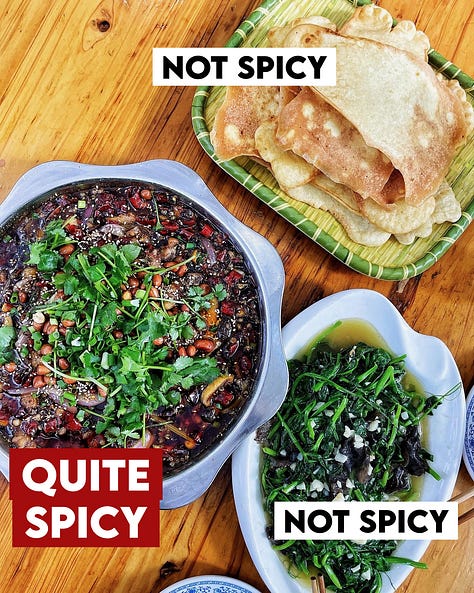
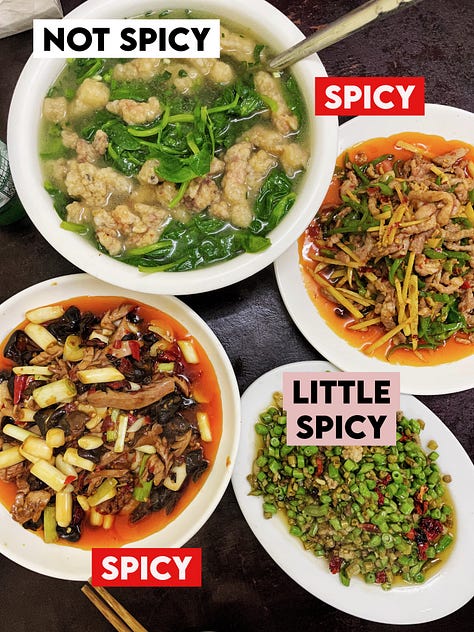
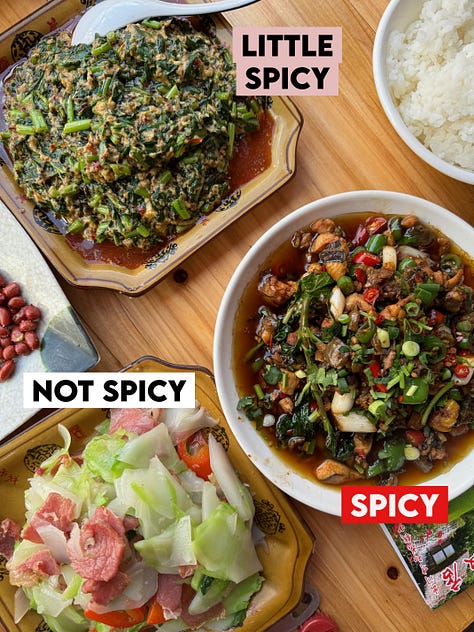
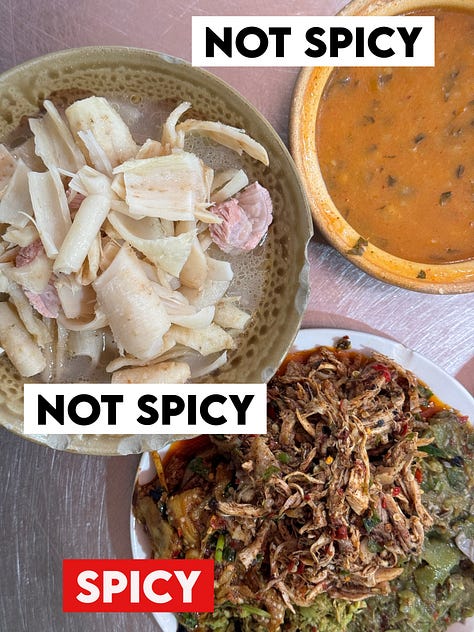
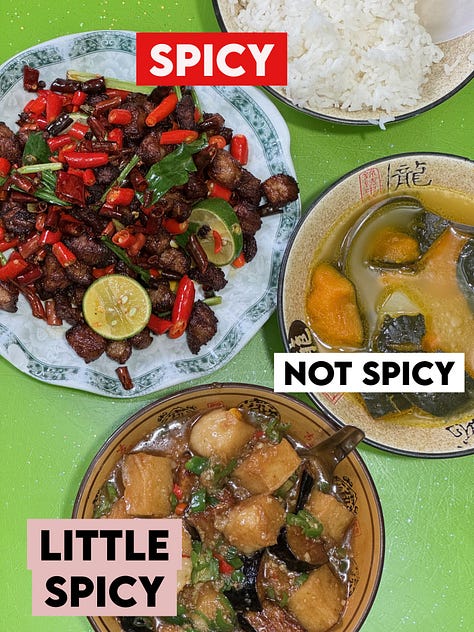
This is not a gamut of hot wings — there’s a mix here between the spicy, the little bit spicy, and the mild. The mild dishes are often vegetable dish and/or soups. For the same reason celery sticks are often there right next to your buffalo wings, they can be a nice break from an otherwise to a chili-laced meal. But at the same time, even that cultural comparison might be a little overly reductive — these are a proper dishes, not simply a glass of milk to make the heat go away.
I think we all sort of know this in the back of our head, but the unfortunate matter is that “spicy red oil” sells in a way that ‘boiled pumpkin soup’ does not. We enjoy spicy food ourselves, so we’ve been more than happy to meet that demand over the last eight years, but it’s inadvertently made our ‘Learn Sichuan Cuisine’ playlist about as red as the stereotype.
We need to cover the rest of the table better.
Yunnan Peanut Milk Soup
Peanut Milk Soup (花生汤) is a dish that you can find around the south of Yunnan. In last week’s ‘Chinese regional cuisines’ post, we marked it as a representative dish of Honghe, but it’s enjoyed quite a bit in neighboring Pu’er as well (there’s a reason why that exercise was maddeningly difficult). A commenter under that video was really curious in the dish and couldn’t seem to find anything on it, so we figured it’d be a decent one to cover.
The most basic version of this soup is absurdly simple, bordering on a non-recipe. You take some peanuts – classic is fresh, but dried is also quite common – and you blend it with water. If you’re using dried peanuts, it’s better if you can slightly soften them up with a quick soak, but even that is squarely optional. You then boil the peanut liquid, and cook the vegetables in it. Fin.
The most famous application of peanut milk in Yunnan is, however, in the aforementioned city of Pu’er. There, there’s a specific peanut milk rice noodle soup that’s… aggressively awesome:
In addition to that whole smorgasbord of toppings that he shows at 0:49 in the video, it’s a bit thicker, and served with a specific sort of rice noodle (made from their local red rice). I promise one day we’ll cover the thing, but to do the dish justice we should probably focus a proper post on just that dish — after all, the toppings are their own mountain to climb.
That said, outside Pu’er (specifically in the hills around Zhenyuan) there’s another local peanut milk that shares some similar ideas — albeit sans rice noodle, sans topping-smorgasbord. The fundamental commonality lies in the heft of the thing: it’s thicker, richer, and might be a decent route if you’re the type that prefers more… viscous western style soups.
Thin Version
Ingredients and Sourcing
Dried Peanuts, 100g. Untoasted, unroasted, unfried. In Yunnan they’ll often reach for their (much beloved) local red peanuts (红皮花生), which gives the soup a slight mauve hue. Fresh peanuts are also an option.
Water, 1L. To blend with the peanuts.
Leafy Vegetable of choice, ~120g. In Yunnan, the most classic to see with this dish are pumkin greens (南瓜尖). You can also see it cooked with Napa Cabbage. Of commonly available western vegetables, watercress (西洋菜), bok choy (小白菜), and spinach would all be solid choices. Just maybe avoid a vegetable that would have a strong taste to it (e.g. gailan, mustard greens, dandelion greens) or hearty greens that would take a while to cook (e.g. collards, kale).
Seasoning, to taste, or:
Salt, ½ tsp
MSG (味精), ½ tsp
Recipe, Thin Version
Optionally soak:
100g dried peanuts
in with cool water for at least two hours and up to overnight. After soaking, drain the water and rinse the peanut. The soak is optional but will help make the final soup less grainy.
Blend the peanuts with
1L cool water
and set aside.
Rinse and pick
~120g of your leafy vegetable of choice
Add the blended peanut water to a wok or pot and bring up to a rapid boil. Add the leafy greens and boil until cooked. Season the soup to taste — we used:
½ tsp each Salt and MSG
Thick Version
Ingredients and Sourcing
Dried Peanuts, 100g. Same as above — untoasted, unroasted, unfried.
Water, 500mL. To blend with the peanuts, double the concentration as above.
Pork belly, 70g -or- lard, 2 tbsp -or- vegetable oil, 2 tbsp. In the video we rendered out some lard from a bit of pork belly, as we’re currently out of lard (and I didn’t want to make another batch right before being out of town for a month). If you have lard, feel free to use it straight up. I enjoy lard as a base here, but you can also absolutely use vegetable oil as well.
Aromatics:
Ginger, ~1 inch. Minced.
Garlic, ~3 cloves. Minced.
Leafy Vegetable of Choice, 60g. Chopped.
Optional: Dill, 1 sprig -or- Common Fennel (茴香), 2-3 sprigs. Common fennel (not to be confused with the internationally more ubiquitous Florence fennel) is a popular addition to this sort of soup in Yunnan, but it can be difficult to find outside of China. Dill is related and hits some similar notes, but has a much stronger flavor to it. We added a sprig of dill. You can also skip it, add more, or (obviously) swap for common fennel.
Seasoning, to taste, or:
Salt, ½ tsp
MSG (味精), ½ tsp
Sugar, ¼ tsp
Recipe, Thick Version
Optionally soak:
100g dried peanuts
in with cool water for at least two hours and up to overnight. After soaking, drain the water and rinse the peanut. Blend the peanuts with
500mL cool water
and set aside. Rinse and pick
~60g of your leafy vegetable of choice
and chop into ~½ inch sections. If using, also pick:
~1 sprig of dill
and set aside. Mince:
~1 inch of ginger
3 cloves of garlic
and set aside. If using, slice and render the lard out from:
70g pork belly
You should have about 2 tbsp of lard. You do not need the crispy pork belly (you can eat it as a snack).
In a wok over a medium flame, fry the minced garlic and ginger in the lard or oil until fragrant, ~30 seconds. Add the dill and leafy greens, and fry until wilted, ~1 minute.
Add the blended peanut milk and swap the flame to high. Bring up to a rapid boil, then swap the flame back down to medium. Let the peanut milk bubble for at least two minutes, or until thickened to your liking. We look for a porridge-like consistency.
Season, to taste. We seasoned with:
½ tsp each salt and MSG; ¼ tsp of sugar

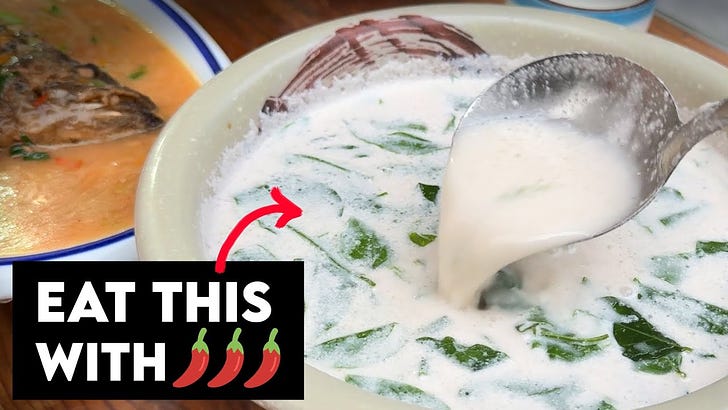


Ooh sounds simple and delicious! We've only had the sweet version, so this is an eye-opener, thanks ☺️.